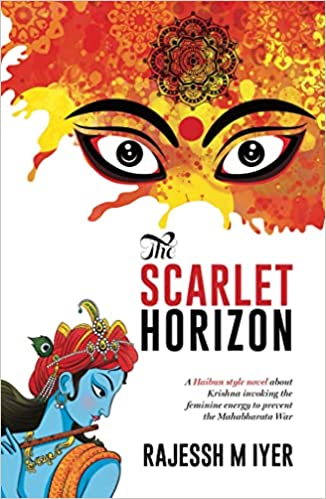Dec 24, 2025
Dec 24, 2025
The Scarlet Horizon; Rajessh M Iyer
Proviso: Review of a fictional novel based on mythology.
 ‘Mahabharata’ is a well-known epic to most of us; I was introduced to the most complicated tale of Mahabharata at young age itself through Rajaji’s famous ‘Vyasar Virunthu,’ which almost presented the long winding, complicated tale in a precise form without scarifying the content or the characters.
‘Mahabharata’ is a well-known epic to most of us; I was introduced to the most complicated tale of Mahabharata at young age itself through Rajaji’s famous ‘Vyasar Virunthu,’ which almost presented the long winding, complicated tale in a precise form without scarifying the content or the characters.
Naturally, there were several other stories and novels written by many authors extending their creativity from a character or an incident from Mahabharata or Ramayana. Though I haven’t read them all, I remember two contemporary short stories written one on ‘Mahabharata’ and another from ‘Ramayana’. The first one is ‘Aswaththama’ by Indira Parthasarathy and another ‘Urmila’ by Manian in the Ramayana. These two are still green in my memory.
Well, now let me talk about this slightly voluminous novel ‘Scarlet Horizon’ by Rajessh M Iyer. It is interesting because the author tries the best of his imagination on how Krishna tries to invoke the feminine energy to prevent the Mahabharata War.
So what is Krishna’s mission?
Krishna consults Pandava before his visit as envoy to Kaurav king Duryodhan whether a war is the only option since they know the arrogance and obstinacy of Duryodhan. He receives mixed views with Sahadev who is considered to be the most knowledgeable and balanced man and is the first one to suggest warfare. Others ultimately support the view.
But, Krishna thinks differently; he feels the woman power, the several important and less known women characters in Mahabharata would listen to his wise suggestion of stopping the major war. In fact, these women are no fools or dimwits. They are knowledgeable and wise. So he tries to invoke the different forms of Mahavidyas; Kali, Tara, Tripura Sundari, Bhuvaneswari, Chinnamasta, Bhairavi, Dhumavati, Bagalamukhi, Matangi and Kamalatmika. Each manifestation of Shakti represents different energy forms.
So he volunteers and meets Lakshmanaa (Duryodhan’s daughter), Kunti, Gandhari, Ponnuruvi (Karna’s wife), Sulabha (Vidura’s wife), Kripi (Drona’s wife), Bhanumati (Dhuryodan’s wife), Arshi (Sakuni’s wife), Draupathi and Uttara (Abhimanyu’s wife).
Krishna as his wont tactfully speaks to each one and tries to make them realize their power and use their intelligence to talk to their respective men and dissuade them from creating a holocaust through the war.
Though all these women understand what Krishna is influencing them to do but they have their own pride, prejudice, anger, frustration, indifference or fear. These are the most interesting parts of this interesting novel. Krishna later explains this to Arjun and Sahadev.
The savoir-faire fails. Towards the end, Krishna realizes all his attempts had come to nought. The night of invocation is fraught with frightening omens. The sky changes its shade with the differing clashes of several forms of Shakti.
Krishna looks outside at the ‘Scarlet Horizon’ and knows that goddess was ready with her fiercest form. The novel ends thus but with a starting of the warfield which I feel is superfluous.
Why Scarlet?
The author says according to the lexicon Scarlet as a bright-red color inclining towards orange. According to Hindu Culture Red indicates both sensuality and purity. The author feels ‘the horizon going scarlet means transformation.’
Very well written in lucid language with haikus and free verse poems strewn in between, the novel sustains the interest of the reader provided the reader is familiar with ‘Mahabharata’ and its events and characters.
03-Feb-2023
More by : G Swaminathan